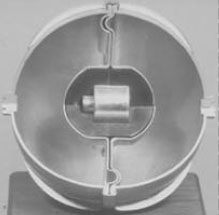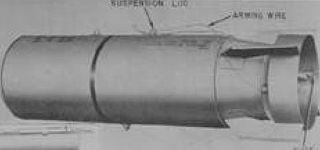
The E120 bomblet was a biological cluster bomb sub-munition developed to disseminate a liquid biological agent. The E120 was developed by the United States in the early 1960s.

The E120 bomblet was a biological cluster bomb sub-munition developed to disseminate a liquid biological agent. The E120 was developed by the United States in the early 1960s.
The E120 bomblet was one of several biological weapons that were developed before the United States abandoned its offensive biological warfare program in 1969–1970. [1] The E120 was developed in the early 1960s. [2] The Schu S-4 strain of the tularemia bacterium was standardized as Agent UL for use in the E120 bomblet. [3]
The E120 was a spherical bomblet with a diameter of 11.4 centimeters. [2] It was designed to hold 0.1 kilograms of liquid biological agent. Much like the M139 bomblet, the E120 had exterior "vanes". However, the vanes' function on the E120 was to cause the bomblet to rotate as it fell, thus shattering and rolling around upon impact while spraying the agent from a nozzle. [2]

A cluster munition is a form of air-dropped or ground-launched explosive weapon that releases or ejects smaller submunitions. Commonly, this is a cluster bomb that ejects explosive bomblets that are designed to kill personnel and destroy vehicles. Other cluster munitions are designed to destroy runways or electric power transmission lines, disperse chemical or biological weapons, or to scatter land mines. Some submunition-based weapons can disperse non-munitions, such as leaflets.

Tularemia, also known as rabbit fever, is an infectious disease caused by the bacterium Francisella tularensis. Symptoms may include fever, skin ulcers, and enlarged lymph nodes. Occasionally, a form that results in pneumonia or a throat infection may occur.
The United States biological weapons program began in 1943 and was discontinued in 1969.

The M139 bomblet was an American sub-munition designed for use in warheads as a chemical cluster munition. Each spherical bomblet held 590 grams (1.3 lb) of sarin nerve agent.
The M143 bomblet was a biological cluster bomb sub-munition developed by the United States during the 1960s. The spherical bomblet was the biological version of the Sarin-filled M139 chemical bomblet.

The M33 cluster bomb, also known as the (M33) Brucella cluster bomb, was a U.S. biological cluster bomb developed in the early 1950s and deployed in 1952. It was the first standardized biological weapon in the U.S. arsenal.

The M114 bomb was a four-pound U.S. anti-personnel bomb and biological cluster bomb sub-munition. The M114 was used in the M33 cluster bomb.

The Flettner rotor bomblet was a U.S. biological sub-munition that was never mass-produced. Based on the vertical Flettner rotor which takes advantage of the Magnus effect, a force acting on a spinning body in a moving airstream, it was developed toward the end of the U.S. biological weapons program in the 1960s.

The M34 cluster bomb was the first mass-produced United States Army weapon meant to deliver the chemical agent sarin (GB). A large stockpile of M34s was destroyed between 1973 and 1976.

The M43 BZ cluster bomb, or simply M43 cluster bomb, was a U.S. chemical cluster bomb intended to deliver the incapacitating agent known as BZ. The weapon was produced in the early 1960s and all stocks of U.S. BZ were destroyed by 1989.
The M138 bomblet was a sub-munition of the U.S. chemical weapon, the M43 BZ cluster bomb. The bomblet contained BZ, an incapacitating agent and was developed with the M43 in 1962. The M138s, along with all other U.S. BZ weapons were destroyed during the 1980s.
The E14 munition was a cardboard sub-munition developed by the United States biological weapons program as an anti-crop weapon. In a series of field tests in 1955, the E14 was loaded with fleas and air-dropped.
The E86 cluster bomb was an American biological cluster bomb first developed in 1951. Though the U.S. military intended to procure 6,000 E86s, the program was halted in the first half of the 1950s.
The E61 anthrax bomblet was an American biological sub-munition for the E133 cluster bomb. This anti-personnel weapon was developed in the early 1950s and carried 35 milliliters of anthrax spores or another pathogen.
The M125 bomblet was a U.S. chemical sub-munition designed to deliver the nerve agent sarin. It was brought into service in 1954 with the M34 cluster bomb as part of the first U.S. air-delivered nerve agent weapon.

The MC-1 bomb was the first U.S. non-clustered air-dropped chemical munition. The 750-pound (340 kg) MC-1 was first produced in 1959 and carried the nerve agent sarin.

The M134 bomblet was a U.S. chemical sub-munition designed for use in the Honest John rocket during the 1950s. The weapon was never mass-produced and was supplanted in 1964 by an improved design, the M139.
Before the 20th century, the use of biological agents took three major forms:
| Wikimedia Commons has media related to E120 bomblet . |